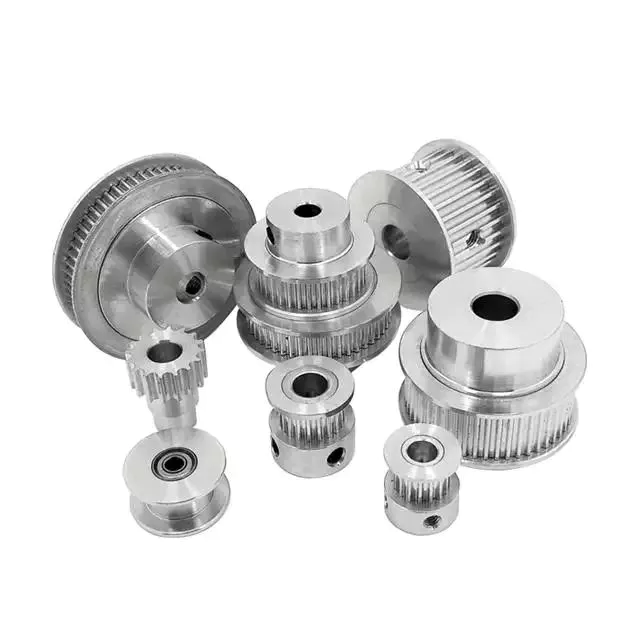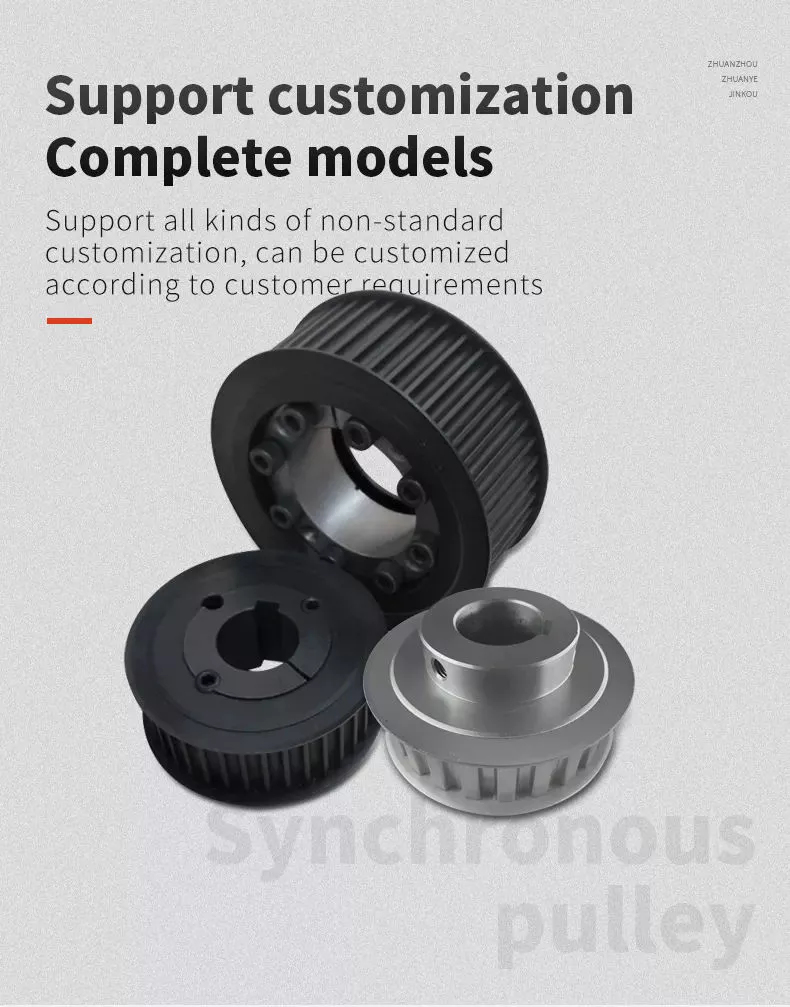Produktbeschreibung
Produktbeschreibung
Casting Iron Elevator Sheave Pulley for Lift Parts
Pulley Advantages:
1. Low cost &Low specific weight
2. Great rigidity ,hardness ,Corrosion resistant ,Friction-resistant and wear-resistant.
3. High impact value,Excellent sliding and emergency running properties
4. No, or very low moisture absorption
5. Dimensionally stable .Virtually no limit to the variety of dimensions and shapes
6. Low or no maintenance required
What’s more important is:
Energy efficient and environment-friendly and Can be customized ~
| Load | Speed | Outer diameter Φ | Inner diameter Φ | Wire rope diameter Φ | Grooves N |
| 450 | 0.5-1.75 | 320 | 80-110 | 8 | 3-4 |
| 550 | 1-1.75 | 320 | |||
| 630 | 1-1.75 | 320 | |||
| 800 | 1-1.75 | 320 | 100-120 | ||
| 400 | |||||
| 1000 | 1-2.5 | 320 | 110-130 | 8-10 | 5-8 |
| 400 | |||||
| 440 | |||||
| 480 | |||||
| 520 | |||||
| 1150 | 1-2.5 | 320 | 120-140 | 8-12 | 5-8 |
| 400 | |||||
| 440 | |||||
| 480 | |||||
| 520 | |||||
| 1250 | 1-2.5 | 400 | 120-140 | 8-12 | 6-8 |
| 440 | |||||
| 480 | |||||
| 500 | |||||
| 520 | |||||
| 1350 | 1-2.5 | 400 | 130-150 | 8-12 | 7-9 |
| 480 | |||||
| 520 | |||||
| 560 | |||||
| 1600 | 1-2.5 | 400 | 140-170 | 10-12 | 8-14 |
Company Infomation
Work Shop
CE Certifications
Project Cases
Häufig gestellte Fragen
1. The Elevator Stable and Safe?
We with more than 10years production experience. Currently working with Ots,Kone and customers from more than 20countries.Our Products are Qualified with ISO9001,CE/EN81,EAC,KC.All the main parts which we use is international famous brand,make our elevator comes premium level.
2.How To Install and Maintain ?
We have been cooperated with elevator installation company more than 20countries,we never stop finding installation partner in other country everyday.To ensure our customer can enjoy both good quality and after-sales service.
3. Will The Elevator Drop Down or Clamp People Suddenly?
Our elevator get 6 lines protection ,In Machineroom,Elevator Door,Bottom of shaft. It will enter into the protection system automaticly if there is any issue .The elevator will not have such situation if the after service goes well.That’s why we have so many parters all over the world.
4. Any Cerifications ?
We are qualified with CE/EN81,EAC/CU-TR,KC,TUV Certificates.You are full protected.
Choose us.Choose ur Life Style!
| Kundendienst: | on-Line Tech. Guidance |
|---|---|
| Warranty: | 1year |
| Typ: | Traction System |
| Suitable for: | Elevator, Funicular Car |
| Load Capacity: | 3000kg |
| Persons: | 11-20 |
| Proben: |
US$ 6.8/Piece
1 Stück (Mindestbestellmenge) | |
|---|
| Anpassung: |
Verfügbar
| Kundenspezifische Anfrage |
|---|

Can you explain the concept of “efficiency” in pulley systems?
In pulley systems, efficiency refers to the ratio of output work or power to the input work or power, taking into account any losses or inefficiencies in the system. It represents how effectively the pulley system converts the input energy into useful output energy.
The efficiency of a pulley system can be affected by various factors, including friction, mechanical losses, and the design and condition of the pulleys and ropes. Here are some key points to understand about efficiency in pulley systems:
1. Mechanical Advantage and Efficiency: Pulley systems can provide a mechanical advantage by reducing the effort force required to lift a load. However, it’s important to note that while a higher mechanical advantage generally means less effort is needed, it may also result in lower efficiency. This is because as the mechanical advantage increases, the system may experience higher frictional losses and other inefficiencies.
2. Friction and Efficiency: Friction plays a significant role in the efficiency of pulley systems. The interaction between the pulley wheels and the ropes or belts can result in frictional losses, which reduce the overall efficiency of the system. Friction can be minimized by using pulleys with low-friction bearings or by lubricating the contact surfaces.
3. Rope or Belt Material: The choice of rope or belt material can impact the efficiency of a pulley system. Different materials have varying coefficients of friction, flexibility, and durability, which can affect the overall efficiency. For example, using a rope or belt with low friction and high strength can help reduce energy losses and improve efficiency.
4. Pulley Design and Condition: The design and condition of the pulleys also influence efficiency. Pulleys should be properly aligned, have smooth surfaces, and be free from damage or wear. Misaligned or worn pulleys can increase friction and decrease efficiency.
5. System Load: The efficiency of a pulley system can vary based on the magnitude of the load being lifted or moved. Higher loads can result in increased friction and mechanical losses, leading to lower efficiency.
Efficiency is typically expressed as a percentage, with 100% representing a perfectly efficient system where all the input energy is converted into useful output energy. In real-world pulley systems, efficiency is often less than 100% due to various factors, including friction, heat generation, and other losses.
It’s important to consider efficiency when designing or evaluating pulley systems. Higher efficiency means a more effective use of input energy, reduced energy waste, and improved overall performance.

Welche Rolle spielen Seilrollen in modernen Aufzügen und Hebezeugen?
Pulleys play a crucial role in modern elevators and hoists, enabling the smooth and efficient vertical movement of loads. They are integral components of the lifting mechanisms, providing mechanical advantage and facilitating safe and controlled operation. Here’s how pulleys are used in modern elevators and hoists:
1. Lifting Mechanism: In elevators and hoists, pulleys are part of the lifting mechanism that moves the load vertically. They are typically combined with cables, ropes, or belts to create a pulley system. By distributing the load’s weight across multiple lines and changing the direction of the applied force, pulleys make it easier to lift heavy loads. The number and arrangement of pulleys can vary depending on the specific design and requirements of the elevator or hoist.
2. Gegengewichtssysteme: Moderne Aufzüge verwenden häufig Gegengewichtssysteme, um das Gewicht der Aufzugskabine auszugleichen und den für den Betrieb erforderlichen Stromverbrauch zu reduzieren. Rollen spielen in diesen Systemen eine entscheidende Rolle, indem sie die mit dem Gegengewicht verbundenen Kabel führen. Wenn sich die Aufzugskabine nach oben oder unten bewegt, bewegt sich das Gegengewicht in die entgegengesetzte Richtung und gleicht die Last aus. Die Rollen im Gegengewichtssystem helfen, das Gewicht zu verteilen und eine reibungslose Bewegung zu gewährleisten.
3. Traktionskontrolle: Riemenscheiben sind auch am Traktionskontrollmechanismus von Aufzügen und Hebezeugen beteiligt. Traktionsaufzüge verwenden Seile oder Riemen, die über eine Reihe von Riemenscheiben, sogenannte Seilscheiben, laufen, um Traktion zu erzeugen. Ein Elektromotor treibt die Seilscheiben an und versetzt die Seile oder Riemen in Bewegung. Durch Einstellen der Drehbewegung der Seilscheiben können Geschwindigkeit und Richtung des Aufzugs oder Hebezeugs gesteuert werden. Die Riemenscheiben im Traktionskontrollsystem ermöglichen einen präzisen und zuverlässigen Betrieb.
4. Safety Systems: Pulleys play a crucial role in the safety systems of elevators and hoists. For example, in traction elevator systems, overspeed governors utilize pulleys to detect excessive speed and activate the safety brakes in case of a malfunction. The pulleys in these safety systems help monitor and control the elevator’s speed, ensuring passenger safety.
5. Wartung und Service: Die Rollen moderner Aufzüge und Hebezeuge sind auf Langlebigkeit ausgelegt und erfordern nur minimale Wartung. Sie sind häufig mit abgedichteten Lagern oder anderen Schmiersystemen ausgestattet, um Reibung und Verschleiß zu reduzieren. Dies gewährleistet die Langlebigkeit und Zuverlässigkeit der Rollensysteme und minimiert Ausfallzeiten und Wartungskosten.
Insgesamt sind Seilrollen wesentliche Komponenten moderner Aufzüge und Hebezeuge, da sie vertikale Bewegungen ermöglichen, mechanische Vorteile bieten, Sicherheit gewährleisten und einen effizienten Betrieb ermöglichen. Sie tragen zum sanften und kontrollierten Heben von Lasten bei und machen Aufzüge und Hebezeuge zu zuverlässigen und unverzichtbaren Werkzeugen in verschiedenen Branchen und Gebäuden.

In which industries are pulleys extensively used?
Pulleys are extensively used in various industries for a wide range of applications. Here are some of the industries where pulleys find extensive use:
1. Manufacturing and Industrial: Pulleys are widely used in manufacturing and industrial settings. They are employed in conveyor systems for material handling, assembly lines, and production processes. Pulleys are also utilized in machinery and equipment such as pumps, compressors, generators, and conveyors. These industries rely on pulley systems for efficient movement of materials, power transmission, and mechanical advantage.
2. Construction and Engineering: The construction and engineering industries heavily rely on pulleys for lifting and moving heavy loads. Cranes, hoists, and winches utilize pulley systems to provide mechanical advantage and precise control over lifting operations. Pulleys are also employed in scaffolding systems, elevators, and material handling equipment used in construction projects.
3. Mining and Quarrying: In mining and quarrying operations, pulleys are used in various applications. They are utilized in conveyor systems to transport bulk materials such as coal, ore, and aggregates. Pulleys play a crucial role in mining equipment such as crushers, screens, and excavators, enabling efficient material handling and processing.
4. Transportation and Logistics: The transportation and logistics industries utilize pulleys in various ways. Pulleys are integral components in vehicles, including cars, trucks, buses, and trains. They are used in engines, power steering systems, alternators, and air conditioning systems. In logistics, pulleys are employed in conveyor belts and sorting systems for efficient movement of packages and goods in warehouses and distribution centers.
5. Agriculture and Farming: Pulleys have significant applications in the agriculture and farming sectors. They are used in machinery such as tractors, combines, and harvesters for power transmission and drive systems. Pulleys are also utilized in irrigation systems, grain elevators, and feed processing equipment.
6. Marine and Offshore: Pulleys find extensive use in marine and offshore industries. They are employed in shipbuilding, offshore drilling rigs, and maritime equipment. Pulleys are used in winches, cranes, anchor systems, and rigging applications. They enable safe and efficient lifting, lowering, and positioning of heavy equipment and cargo on ships and offshore platforms.
7. Energy and Utilities: The energy and utilities sectors utilize pulleys in power generation and transmission systems. Pulleys are used in turbines, generators, and power plants to transfer rotational motion and transmit power. They are also employed in renewable energy systems such as wind turbines and hydroelectric plants.
8. Entertainment and Stage Production: Pulleys have applications in the entertainment and stage production industries. They are used in theater rigging systems, concert stages, and amusement park rides. Pulleys enable the controlled movement of scenery, lighting equipment, and performers, ensuring smooth and precise operations.
These are just a few examples of the industries where pulleys are extensively used. Pulleys play a crucial role in a wide range of applications, providing mechanical advantage, power transmission, and efficient movement of loads in numerous industrial sectors.


Herausgeber von CX
2023-12-08
